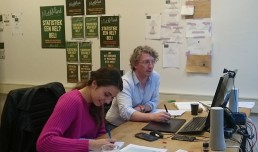Background information
Aanpak past niet.
Het probleem is meestal niet het VAK waar je moeite mee hebt maar de manier WAAROP het vak wordt gedoceerd. Het past gewoon niet bij jouw manier van denken. Daar jouw manier van denken, alleen daar waar nodig, bij te sturen, zul je merken dat jij het WÉL kunt.
Angstcultuur en verouderde vakdidactiek.
Daarnaast hangt rondom vakken zoals wiskunde en statistiek een waas van angst. Hoogstwaarschijnlijk omdat het verplichte vakken zijn, door velen als moeilijk worden ervaren, men elkaar daarin bevestigd, de veelheid aan formules het begrip en samenhang niet ten goede komt, het ontbreken van verbanden en relaties tussen paragrafen en hoofdstukken onderling etc..
Dat terwijl de onderwerpen die bij wiskunde, natuurkunde en statistiek worden behandeld vaak honderden jaren oud zijn en er in al die tijd weinig aan de bijbehorende vakdidactiek is veranderd. Daarom kijken we naast de structuur vooral naar toepassingen die de theorie ondersteunen waardoor de theorie tot ‘leven’ komt. Hiermee proberen we het nut van de theorie te laten zien en hopen daarmee begrip te creëren.
Van taal tot begrip
De basis van het begrijpen is het begrijpen van het ‘begrip’: de term of het woord. En dat begint bij de (Nederlandse) taal. Als een abstract begrip, een abstractie, haar intrede doet wordt dat vaak achteloos geïntroduceerd. Zie het als een soort namedropping. Vervolgens wordt aan dat begrip een uitleg of theorie gekoppeld zonder dat het begrip ‘leeft’. Als het begrip al geen betekenis heeft, hoe kun je er dan informatie aan koppelen (in je hoofd).
Juist door meer aandacht aan het begrip te besteden en te kijken hoe dat begrip in de (Nederlandse) taal wordt gebruikt, ontstaat betekenis. Als het woord eenmaal ‘leeft’ kan naar overeenkomsten binnen worden gezocht. Overeenkomsten tussen het gebruik van het begrip in de (Nederlandse) taal en zoals het begrip in de wiskunde, natuurkunde of statistiek wordt gebruikt.
Het denken analyseren.
Het begrijpen van het begrip is één, het analyseren van het denkproces is twéé. Hoe ziet de redenatie structuur van de leerling of student uit. Juist door hier inzage in te krijgen kan makkelijk bijgestuurd en geholpen worden.

Van theorie naar som
Bijles geven, voor wiskunde, natuurkunde of statistiek, is geen equivalent voor samen sommen maken of sommen voordoen. Het ‘blind’ maken van sommen dient geen doel. Belangrijk is te begrijpen dat de vraag die gesteld wordt, de opgave, een manier is om de theorie die je geleerd heb, toe te passen. Probeer bij het maken van een opgaven te begrijpen welk gedeelte van de theorie wordt bevraagd.
Leren leren.
Leren voor een taal is anders dan voor beta-vak. Het leren van woordjes heeft nut; je kunt er zinnen mee bouwen. Bij een beta-vak heeft het geen zin om sommen of de theorie van buiten te leren. ‘Rijtjes’ leren heeft dus geen. De ‘rijtjes’ moet je leren toepassen en dan ontstaat het begrip en inzicht vanzelf.
Conclusie
Door de uitleg en aanpak zo af te stemmen op de leerling of student, kan iedereen naar een voldoende voor wiskunde, natuurkunde of statistiek worden geloodst. Het bijles traject help niet alleen bij de weg naar die voldoende. De andere of nieuwe manier van denken en leren blijft ook van waarde na je bijles.
Visie
By 'thinking', developing it and learning to rely on it, we believe that we can guide everyone to a satisfactory level for mathematics, physics and statistics. All we deem necessary for this is commitment.
Missie
Uitgangspunt van onze aanpak is dat iedereen uniek is. Daarom wordt de aanpak afgestemd op de wensen, behoeften en bovenal het denkproces van onze leerlingen/studenten. Met deze intensieve en persoonlijke benadering zien wij niet alleen de prestaties verbeteren, ook de zelfdenk- en zelfredzaamheid ontwikkelen zich positief.
Het gaat in onze optiek niet alleen om het vak maar ook om het aanvoelen, inleven in, en het analyseren van de leerling of student. Volgens ons is de basis dat iedere persoon de vrijheid moet kunnen voelen om vrij te denken en zodoende een aanpak te ontwikkelen die voor hem of haar het beste werkt/het beste voelt.
Dus twijfel mag en moet. Twijfelen is onontkoombaar bij het proces van de zelfdenkzaamheid. Het moment van twijfel is juist hét moment dat ruimte ontstaat voor begrip en nieuwe inzichten. Wij ondersteunen dit proces door een gevoel van veiligheid te creëren en een sfeer te bieden waarin ‘fouten’ maken en onzekerheid er mogen zijn.
Wij laten leerlingen en studenten beseffen dat we er enkel voor hen zijn. Wij dragen oplossingen en suggesties aan waardoor zij verder kunnen. Welke oplossing of strategie het beste past, moet zelf bepaald worden. Dit keuzeproces zien wij als onderdeel van de ontwikkeling van de zelfdenk- en zelfredzaamheid.
Om het voorgaande te bereiken is o.a. een “speelplaats” gecreëerd waar kennis kan worden ontdekt, ontwikkeld en worden toegepast. Hiermee hopen wij natuurlijk dat inzet geleidelijk overgaat in motivatie.